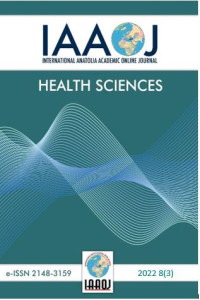Öz
Romatoid Artrit (RA) hastalarının %85’inden fazlasında, ayaktaki eklemlerin tutulumu görülmektedir. Metarsal ağrı, genel ayak ağrısı, hastalık aktivitesi, ayak şiş eklem sayısı ön, orta ve arka ayaktaki problemler, hastalık süresince yürüyüşü etkiler ve bozar. Yürüyüş sırasında yürüyüş hızı, kadansı ve adım uzunluğunu azalır, topuk-parmak paterni zayıflar ve anormal yük dağılımı görülür. RA’lı hastalarda ayağın etkilenmesi nedeniyle talus başı plantar ve medial yönde kayarak, kilitleme mekanizmasının oluşmasını önler. Arka ayaktaki instabilite nedeniyle ağırlık daha çok medial taraftan taşınır. Bu durum medial arkın depresyon artışına, calcaneusun dışa rotasyonuna ve yük verme sırasında arka ayağın valgus deformitesine neden olur. Ayağın pronasyonu, inversiyon yönünde kısıtlanmaya ve tibilis posterior kasının uzamasına böylece zayıflamasına sebep olmaktadır. Ayrıca, ayağın pronasyon deformitesi, aynı taraf bacağı genu valguma gitmesi yönünde meylettirmektedir. Arka ayaktaki bu insitabilite, zamanla ön ayağa doğru ilerleyerek, ön ayakta spesifik olarak halluks valgus deformitesinin gelişimine neden olur. Halluks valgus deformitesi ilerledikçe de, metatarsofalangeal (MTP) eklemlerde subluksasyon ve dislokasyonun görülür. 1.MTP eklemdeki sertlik, maksimum dorsi fleksiyonu’nu yürüyüş sırasında limitlemektedir. Sonuç olarak aşil tendonu ile kalkaneus arasındaki bursa, artrit sebebi ile iltihaplanabilir, kalkaneal erozyon kemik dokuda supurlara ve plantar aponeurosisin yapıştığı alanda düzensizliğe neden olabilir. RA’lı hastalarda yürüme bozukluklarını değerlendirmek için tüm parametreleri kapsayan ayrıntılı bir değerlendirmeye ihtiyaç duyulmaktadır.
Anahtar Kelimeler
Kaynakça
- 1. Firestein GS, Budd RC, Gabriel SE, McInnes IB, O’Dell JR, Kelley WN. Kelley’s Textbook of Rheumatology. 9th ed. Philadelphia, Pa.: Elsevier/ Saunders; 2013:1059-1108.
- 2. Cush JJ, Weinblatt ME, Kavanaugh A. In: Weinblatt ME, Kavanaugh A, editors. Rheumatoid arthritis. J.J. Cush. 4th edition. New York (NY): Professional Communications; 2014.
- 3. Scott DL, Wolfe F, Huizinga TW. Rheumatoid arthritis. Lancet 2010;376(9746): 1094-1108.
- 4. O'Dell JR. Rheumatoid Arthritis: The Clinical Picture. In: Koopman WJ, Moreland LW. Arthritis and Allied Conditions: Textbook of Rheumatology. 15th ed. Philadelphia: Lippincott, Williams & Wilkins 2005;1165-1194.
- 5. Weiss RJ, Wretenberg P, Stark A, et al. Gait pattern in rheumatoid arthritis. Gait Posture 2008;28:229–234.
- 6. Rosenbaum D, Hautmann S, Gold M, Claes L. Effects of walking speed on plantar pressure patterns and hindfoot angular motion. Gait Posture 1994;2:191–7.
- 7. Marshall RN, Myers DB, Palmer DG. Disturbance of gait due to rheumatoid arthritis. J Rheumatol 1980;7:617-623.
- 8. Shields MN, Ward JR. Treatment of related knee-ankle-foot deformities in rheumatoid arthritis. Phys Ther 1966;46:600-605.
- 9. Inman VT, Ralston HJ, Todd F. Human Walking. In: Baltimore. The Williams & Wilkins Co 1981;30-75.
- 10. Michelson J, Easley M, Wigley FM, et al. Foot and ankle problems in rheumatoid arthritis, Foot Ankle Int 1994;15:608–613.
- 11. Canseco K, Long J, Marks R, et al. Quantitative characterization of gait kinematics in patients with hallux rigidus using the Milwaukee foot model. J Orthop Res 2008;26:419–427.
- 12. Sarıca Y, Beyazova M. Yürüme Bozuklukları ve Düşme. In: Yavuzer G. Yürüme Analiz Sistemleri. Güneş Tıp Kitap Evi, 2014;191-195.
- 13. Cutlip RG, Mancinelli C, Huber F, et al. Evaluation of an instrumented wlakway for measurement of the kinematic parameters of gait. Gait Posture 2000;12(2): 134-138.
- 14. Baan H, Eng RD, Nene AV, et al. Gait Analysis of the Lower Limb in Patients with Rheumatoid Arthritis: A Systematic Review. Semin Arthritis Rheum 2012; 41:768-788.
- 15. Yetkin H. Yürüme analizi ve ayak basınç ölçümleri. In: Ege R. Ayak ve ayak bileği sorunları. II. Baskı. Ankara: Türk Hava Kurumu Basımevi. 1999;1109-1118.
- 16. Aydoğ E, Bal A, Aydoğ ST, et al. Evaluation of dynamic postural balance using the biodex stability system in rheumatoid arthritis patients. Clin Rheumatol 2006; 25:462-467.
- 17. Tjon SS, Geurts AC, van’t Pad Bosch P, et al. Postural control in rheumatoid arthritis patients scheduled for total knee arthroplasty. Arch Phys Med Rehab 2000;81:1489-1493.
- 18. Ekdahl C, Andersson SI. Standing balance in rheumatoid artrhritis a comparative study with healthy participants. Scand J Rheumatol 1989;18:33-42.
- 19. Bruce B, Fries JF. The Stanford Health Assessment Questionnaire: Dimensions and Practical Applications. Health Qual Life Outcomes 2003;1:20.
- 20. Kucukdeveci AA, Sahin H, Ataman S, et al. Issues in cross- cultural validity: Example from the adaptation, reliability, and validity testing of a Turkish version of the Stanford Health Assessment Questionnaire. Arthritis Rheum 2004;51:14–19.
- 21. Meenan RF, Mason JH, Anderson JJ, et al. AIMS2. The content and properties of a revised and expanded Arthritis Impact Measurement Scales Health Status Questionnaire. Arthritis Rheum 1992;35:1-10.
- 22. Kaya N, Babadağ K. Romatoid Artritli Bireylerde Sağlığa ilişkin Yaşam Kalitesi. İstanbul üniversitesi FNHYO Dergisi 2004;13(53):51-71.
- 23. Dawson J, Doll H, Coffey J, et al. Responsiveness and minimally important change for the Manchester-Oxford foot questionnaire (MOXFQ) compared with AOFAS and SF-36 assessments following surgery for hallux valgus. Osteoarthritis Cartilage 2007;15:918–931.
- 24. Talu B, Bayramlar K, Bek N, et al. Validity and reliability of the Turkish version of the Manchester-Oxford Foot Questionnaire for hallux valgus deformity evaluation. Acta Orthop Traumatol Turc 2016;50(2):207–213.
- 25. Roos EM, Brandsson S, Karlsson J. Validation of the foot and ankle outcome score for ankle ligament reconstruction. Foot Ankle Int 2001; 22(10): 788-794.
- 26. Karatepe GA, Günaydin R, Kaya T, et al. Validation of the Turkish version of the foot and ankle outcome score. Rheum Int 2009;30:169–173.
- 27. Binkley JM, Stratford PW, Lott SA, et al. The Lower Extremity Functional Scale (LEFS): scale development, measurement properties, and clinical application. North American Orthopaedic Rehabilitation Research Network. Phys Ther 1999;79(4):371–383.
- 28. Citaker S, Kafa N, Kanik ZH, et al. Translation, cross-cultural adaptation and validation of the Turkish version of the Lower Extremity Functional Scale on patients with knee injuries. Arch Orthop Trauma Surg 2016;136(3):389-395.
Ayrıntılar
| Birincil Dil | Türkçe |
|---|---|
| Konular | Sağlık Kurumları Yönetimi |
| Bölüm | Derleme |
| Yazarlar | |
| Yayımlanma Tarihi | 31 Aralık 2022 |
| Yayımlandığı Sayı | Yıl 2022 Cilt: 8 Sayı: 3 |
Dergimizin Tarandığı İndeksler







International Anatolia Academic Online Journal Health Sciences Creative Commons Alıntı-GayriTicari-Türetilemez 4.0 Uluslararası Lisansı ile lisanslanmıştır.






